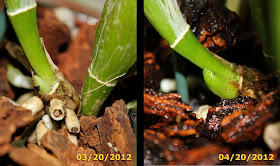Removing a rotten backbulb
I said at the end of last month, that I would wait until my Wilsonara (Oncostele) Pacific Perspective was out of bloom, before repotting and removing the rotting backbulb. Well, last week my new oncidium media arrived from repotme.com, and the oldest two blooms on the flower spike wilted. So I decided it was about time to do some plant surgery.
I used some big scissors to cut off the rotten bulb, and sprinkled cinnamon over the cut (to help prevent rot or infection spreading through the cut site). The remaining bulbs are firm and healthy.
Short roots bristling with growth indicate a problem with the potting condition fungal infection
The state of the roots showed that this orchid was not happy in its old potting media. Although many of the roots from my december update are still alive, all remain very short, as if they did not want to grow any further into the pot. The blackened tips on roots that are less than 5 months old (see above) likewise indicate unwelcome conditions.
Wilsonara in oncidium orchid mix and clear 4" pot
I repotted my wilsonara into a clear 4" pot, which is slightly narrower and deeper than the previous pot. Now that I have one bulb fewer, I can fit the orchid into a smaller container. Since the plant is still extremely top-heavy (and fell out of the new pot as I was moving it around), I also placed the plastic pot inside a slightly larger ceramic pot for extra stability.
Oncidium root deterioration after 4 months in unfit media of untreated fungal infection
Since my wilsonara wasn't doing too well, I decided to also repot my oncidium noid into the new media. I am glad I did, because the oncidium noid's condition was much worse than the wilsonara's. The few roots that had grown in January, were now almost completely rotten.
oncidium root buds that failed to grow
After trimming dead roots: a nearly rootless oncidium remains
I'll admit I was pretty brutal in trimming off the dead root material. In part, I did it because I didn't want any rotting dead plant matter to corrupt the newest growing root tips.
But a greater part of my aggressiveness in the trimming came from the fact that I really don't care about the fate of this orchid. It's a noid that I bought on the cheap, and have never seen in bloom. I don't know if I will like its colors, or even how long it will take to recover enough to bloom for me. It's a large, sick orchid, with pretty green foliage... but that large green foliage is also a pain when it's taking up valuable space under the grow light. (And after the repotting, I moved the orchid to a windowsill for that reason).
New root tips budding from new growth on oncidium
Still, even this sad rescue is putting forth a vigorous effort at growing new roots, with both of the newest growths bristling with little root tips.
My conclusion from this experience is that 'paph&phrag' media does not make a good substitue for other fine-rooted orchid types. Just as my dendrobium victoria-reginae suffered until I moved it out of the paph&phrag media and onto a mount with moss, so did my two oncidiums struggle to grow healthy roots while potted into that media.
As my paphs are growing happily in it, I don't think the media mix itself is bad, but I do think it's clearly not compatible with other orchid genera. The new oncidium mix is much more solid, and provides a greater stability to the potted plant. If I'm right, and the mix was the problem, then I can hope to see healthy long roots on both my oncidiums by the end of summer.
EDIT (11/4): I'm now convinced that the root problems on my oncidiums were the result of fungal issues, rather than improper media. I've since treated my orchids with systemic fungicide, and am finally seeing good progress in root health.




































